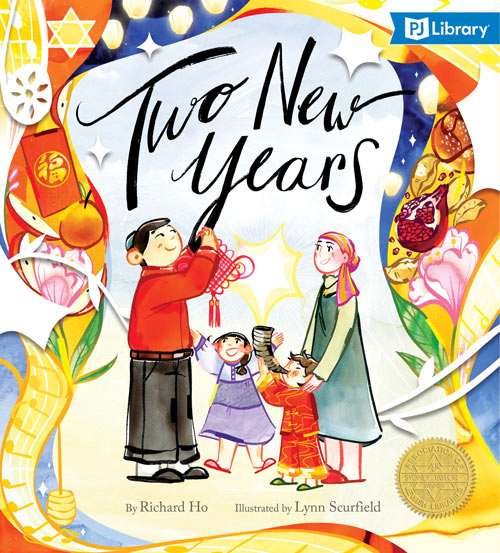
This month, 5-6-year-old subscribers will receive Two New Years, written by Richard Ho and illustrated by Lynn Scurfield. In this vibrantly illustrated book, a Chinese-Jewish family celebrates the joyful traditions of Rosh Hashanah and Lunar New Year. To build on your reading, scroll on for family conversation starters, an activity, and more recommended resources.
Discuss
- How are the Jewish and Lunar New Years similar to one another?
- Looking through the book, what foods do you see on the table during these two celebrations?
- Do you know what they symbolise?
- Both New Year celebrations involve getting over past mistakes. How do people let go of past mistakes during Lunar New Year? How do they do it during the Jewish New Year?
- Are any of the traditions in this book familiar to you? Which ones?
- What traditions in this book are new to you?
- If you were doing tashlich, what would you want to throw away from the past year?
- Which Jewish and Chinese symbols do you spot in the papercut illustrations that appear on the pages of this book?
Make
The back matter of this book outlines some of the many ways that Chinese and Jewish cultures are similar. The illustrations in this book offer a hint to yet another similarity: papercutting is a popular folk art in both cultures. Paper was invented in China in the second century CE, and the Chinese tradition of papercutting stems back to that time. To this day, papercuts are often on display during Chinese festivals and weddings. In Jewish culture, papercuts often make an appearance during weddings as well: they are a popular feature of a ketubah, the marriage contract that’s signed just prior to a wedding ceremony. What a fitting illustration style for a book that celebrates both cultures!
Papercutting is often a very intricate process, but here’s a way to do it that’s simple and fun.
Supplies
- Paper
- Scissors
- Pencil (optional)
Instructions
- Fold down the top right-hand corner of an 8.5- by 11-inch piece of paper so that it touches the bottom left side. Crease the folded edge firmly and trim the bottom of the page. You should have a triangle now.
- Fold one corner of the triangle in toward the opposite corner, forming a smaller triangle. Crease the folded edge firmly. Repeat this step, creating an even smaller triangle.
- If you like, use a pencil to draw where you’d like to make some cuts along the edges. Then, cut!
- Unfold, and your beautiful papercut will be revealed. If you like, you can paste this to a piece of construction paper and write a New Year’s message on it: Shanah Tovah (Happy New Year)!
Learn
In the secular western calendar, New Year’s Day is celebrated for just one day. The High Holidays and Lunar New Year, on the other hand, go for stretches of time — yet another thing the two holidays have in common. Lunar New Year lasts for 15 days, while Rosh Hashanah kicks off the Ten Days of Returning, which finish with Yom Kippur, the Day of Atonement. Before and during the Ten Days of Returning, it is traditional to practice teshuvah (Hebrew for “returning”) — to apologise to others whom we have hurt in the past year, ask forgiveness, and promise to do better in the year to come. The practice of teshuvah helps us to return to our best selves.
More
Tashlich for Kids: Make a “Letting Go” Collage
This Lunar New Year, I'm Embracing My Chinese and Jewish Identities via Jewish Women’s Archive
Helping Kids Create Resolutions for the New Year
Browse PJ Library Books About Rosh Hashanah
September 1, 2024